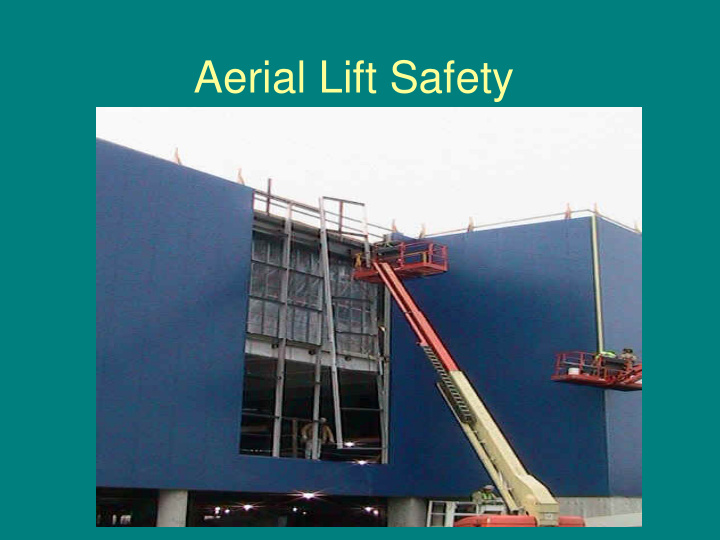



Aerial Lift Safety
Most frequent causes of accidents while using aerial lifts • Failure to recognize electrical hazards • Improper positioning or overloading • Overreaching from basket • Failure to wear fall protection • Moving truck while boom raised
Most frequent causes of accidents while using aerial lifts • Failures of structural or mechanical parts or jamming of controls • Swinging boom or basket against overhead obstructions • Moving boom into positions that interfere with traffic • Inadequate training
Aerial Lift Requirements • Only authorized persons shall operate an aerial lift. • Belting off to an adjacent pole, structure, or equipment while working from an aerial lift shall not be permitted. Some situations may result in a De Minimis citation. Does not apply to scissor lifts
Aerial Lift Requirements • Employees shall always stand firmly on the floor of the basket and shall not sit or climb on the edge of the basket or use planks, ladders or other devices for a work position.
Aerial Lift Requirements • A Body belt* shall be worn and a lanyard attached to the boom or basket when working from a aerial lift. • *As of Jan. 1 1998, body belts are not acceptable as part of a personal fall arrest system. Use of a body belt in a tethering or restraint system is acceptable. • A full body harness is preferred.
Aerial Lift Requirements • Boom and Basket load limits specified by the manufacturer shall not be exceeded. • The brakes shall be set and when outriggers are used, they shall be positioned on a solid surface. Wheel chocks shall be installed before using an aerial lift on an incline, provided they can be safely installed.
Aerial Lift Requirements • An aerial lift truck shall not be moved when the boom is elevated in a working position with men in the basket.
Aerial Lift Requirements • Any “Field Modification” of equipment must be certified by the manufacturer or any other equivalent entity, such as a nationally recognized testing laboratory. • Lift Controls shall be tested each day prior to use to determine that such controls are in safe operating condition
Aerial Lift Requirements • Articulating boom and extensible boom platforms primarily designed as personnel carriers shall have both platform (upper) and lower controls. Upper controls shall be inside or beside the platform within easy reach of the operator. Lower controls shall provide for over- riding the upper controls. Controls shall be plainly marked as to their function. Lower controls shall not be operated unless permission has been obtained from the employee in the lift, except in case of emergency.
Aerial Lift Requirements • Lift shall not be used in the same manner as a crane. (loads may not be suspended and lifted with boom)
Never climb boom to access basket
Be Aware of Overhead Power lines – Stay a minimum of 10 feet away
Never use boom to push aerial platform along the ground, nor attempt to “free” a machine by lifting the wheels off the ground with the boom
Use caution when fueling: Never fill tank with engine running or while smoking near open flame Be sure to use the correct type and grade of fuel Ground the fuel funnel or nozzle against the filler neck to prevent sparks
Summary • Use good common sense • Know the capacity • Check for obstacles that may cause tip- over • Be aware of electrical overhead power lines • Check equipment before use • Look out for others before starting or moving lift
Summary • Operate controls smoothly, never jam controls from one direction to another. • Avoid sudden stops, starts, turns or changes in direction. • Keep everyone clear of a working platform, never allow ground personnel to stand or pass under a raised platform • Never “cowboy” or play games with lift
Recommend
More recommend